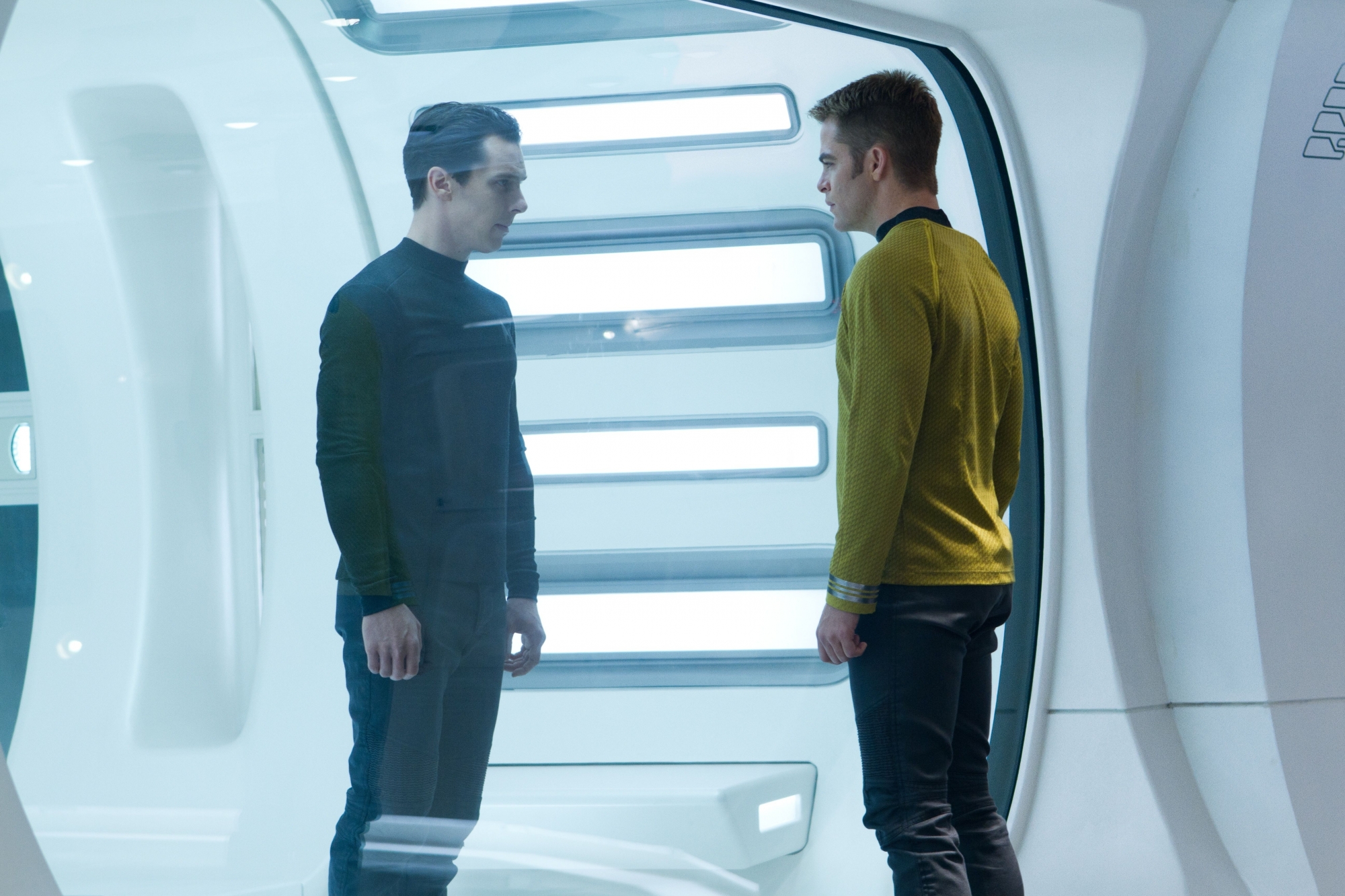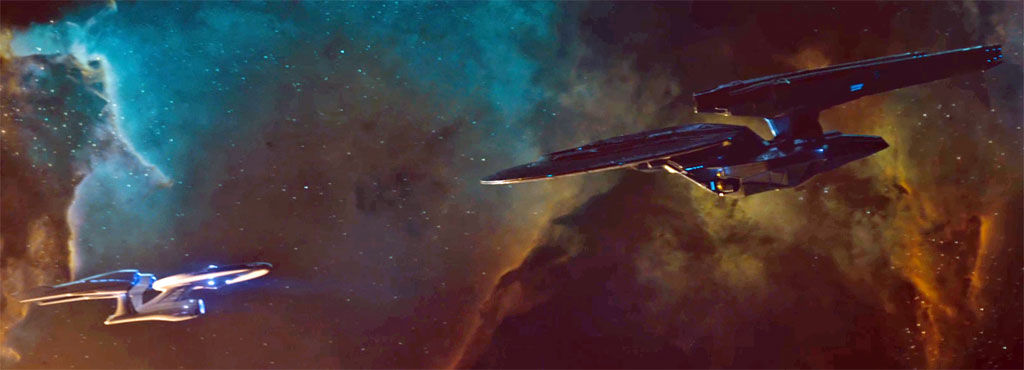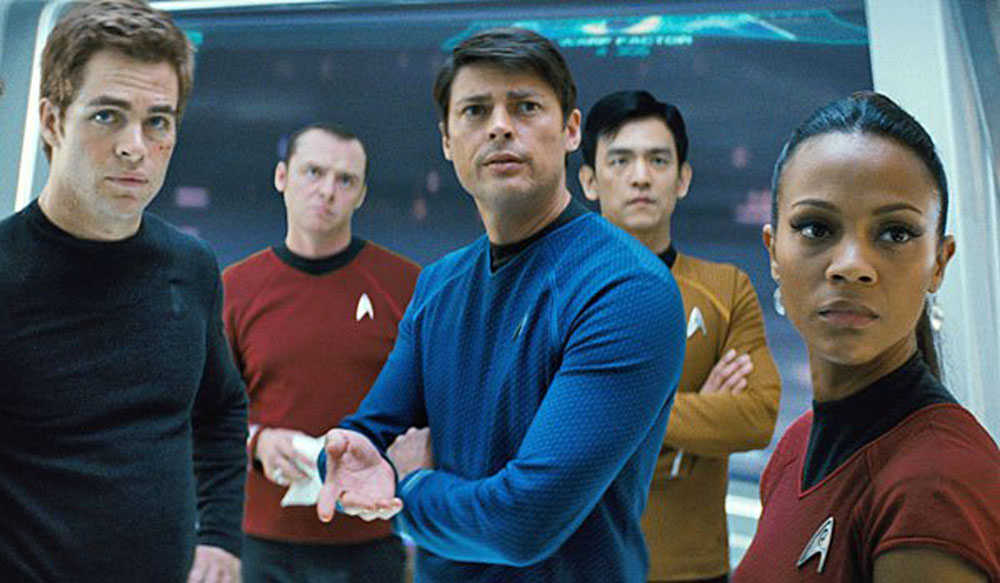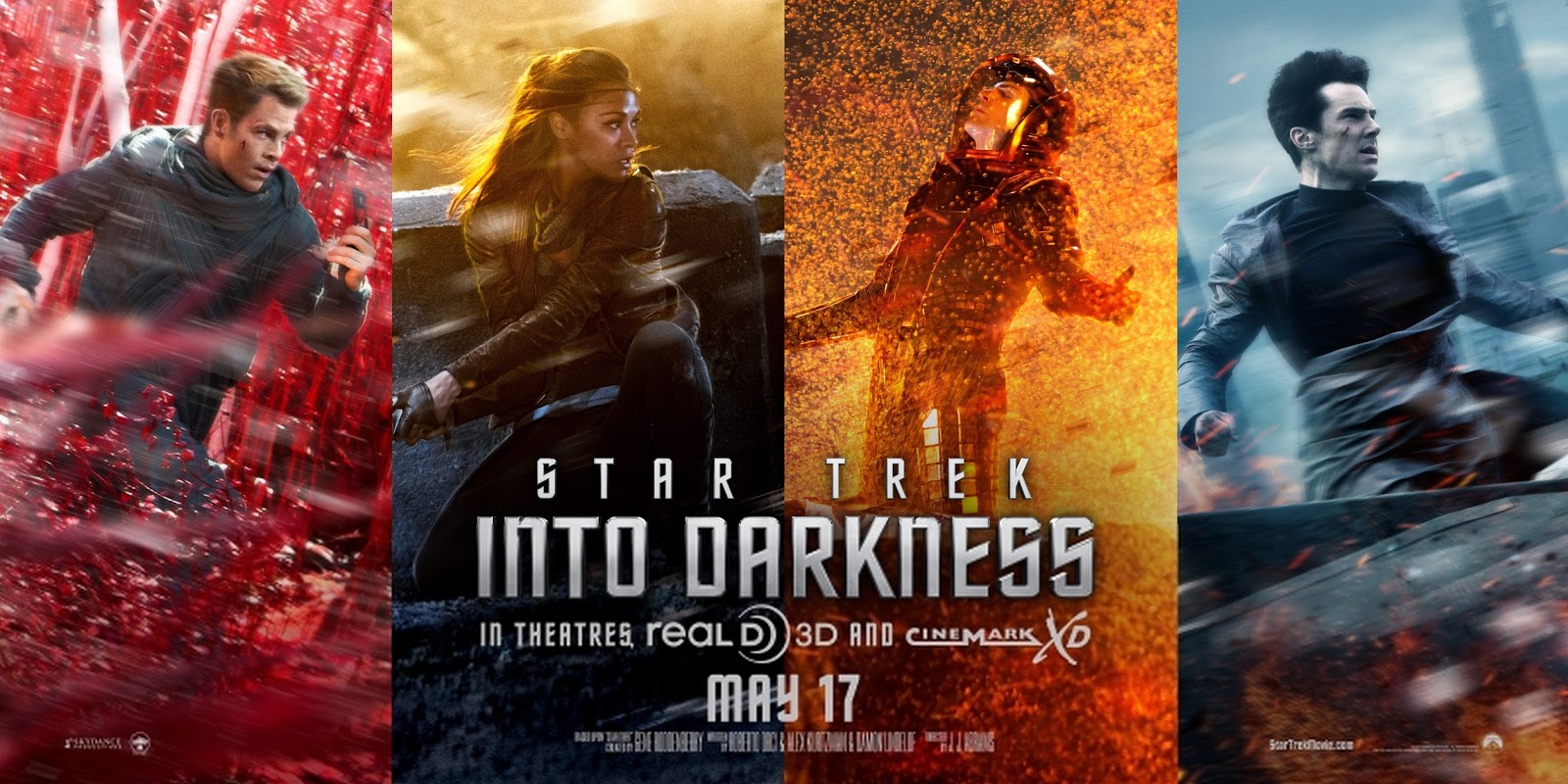Star Trek Into Darkness Review: An Interesting, Arresting Sequel

I was never a Trekkie. I grew up in a time that followed the
Star Trek phenomenon as a son who listened to his father speak about how much he enjoyed watching the TV series in the ‘60s and ‘70s. So consider that I, a non-Trekkie, watched
Star Trek Into Darkness with my father, an ardent fan, and we both came away from watching J.J. Abrams sequel with positive comments and high regards.
Of course, there were some differences in opinion, but for the most part, everything seemed to point to the director’s remarkable ability to make a feature appealing to viewers on both ends of the spectrum.
Right away, the one-hundred thirty-two minute feature hits the ground running as Captain James T. Kirk (played by Chris Pine) cockily turns a routine extraterrestrial planet survey into a full-blooded save-the-world mission. What’s happening? The crew finds the inhabitants of the planet Nibiru about to become extinct as a volcano is set to violently erupt. Kirk then finds himself violating the Prime Directive after facing the dilemma of saving Spock (played by Zachary Quinto) from being engulfed by the natural devastation, or revealing the Enterprise ship to a civilization who Doctor Bones (played by Karl Urban) says has barely invented the wheel.
When Kirk and members get back to Earth, they are either reassigned or demoted as a result of Kirk’s reckless disregard for rules and regulations. But only after what seems like less than a day as a ranking first officer, Kirk gets his captain’s license, and his crew, back as he has been directed to undergo a covert operation to locate and kill a madman, known as John Harrison, who was discovered to be the mastermind behind a bombing that annihilated countless lives in London.

From there, it becomes a catch and release picture, where Kirk is the fisherman and Harrison is the mark. The bait, however, involves the Enterprise crew going into uncharted space territory to hunt down Harrison to either wipe him out or bring him to justice while carrying 72 war torpedoes. But what is inside the torpedoes is something neither the crew initially knows about nor a detail I will reveal.
While watching the movie, you are always a step behind the plot, at the whim of an intentional narrative framing device meant to engage us intellectually rather than twist our arms and bully us. It is these unknown setups, like in the beginning when we wonder why we are seeing Kirk being chased by a group of paint-faced Nibiru aliens while holding a parchment paper, that keeps us in suspense. This is the kind of flick that introduces these what-is-happening moments with heaping morsels of stunning intergalactic action climaxes placed right after the scenes of insight and revelation.

In all seriousness,
Into Darkness is all climax, almost never relenting the spills of thrills. And when it does (briefly) slow down and the characters and dialogue take over, it is thoughtful and meditative, full of raw emotion and dread. I must admit that I was feeling a bit emotional during the beginning when a near-speechless montage of two parents feeling hopeless over their dying child leads to the introduction of the ruthless Harrison.
Who is this Harrison? I will not say, simply because it is a part of the surprise. But Benedict Cumberbatch, the actor who plays the villain, performs with such a precise and exacting combination of low-key dynamism and explosiveness that it might act as a new benchmark for how evilness can be personified in movies. The character is so interesting and the performance so on-the-spot deadly that you forget who the villain was in the 2009
Star Trek.
But with all due respect, every actor in this movie is firing on all cylinders. The cast, mixed in with the twists Abrams inserts, such as Spock and Sulu playing captain while Kirk is elsewhere, adds to the creativity of the picture. In fact, I liked this one more than the first because (1) the villain and his motivations are so much more interesting than the first and (2) I felt so much more comfortable with the cast who puts a big grin on your face every time one of them makes an off-the-cuff quip or a facial expression.

On a $190 million budget, the realism, grandness and frequency of action on display in this film makes it seem like it was budgeted for twice that amount. To say the least, what Abrams does here with that amount is more than impressive, making the 2D action pop like it were 3D. It is so impressive, and the action is so compelling, that you wish the film cut out all the self-referential jokes and pop-culture humor and focused more on being straight-faced and serious.
The direction itself is so good that during a crucial scene near the end I felt like I was experiencing the same weakening feeling a character was suffering from as a result of radiation exposure. And when the camera lens isn’t focused on the interior of the ship or its characters, it is observing both the calm and catastrophic nature of space from long, wide-angled shots. Even when starships are attacked and lives are in peril, the movie is always gorgeously rendered.
It is these certain aesthetic virtues that make me bring into question what critics are talking about when they say that the film is without creativity, artistry, or personality. Though I will not say that I would be able to detect Abrams fingerprint on this or the 2009
Star Trek if I didn’t know he directed them, I view that as fairly arbitrary because that’s like asking someone if he or she knew Danny Boyle directed
127 Hours, considering Boyle has built a reputation for making movies that are without a consistent theme, rhythm or style.
What I will say is that I had high expectations for this film, and for them to be exceeded to such a superlative degree suggests that this is a near-perfect action thriller. In terms of composition and entertainment, the material excels cinematically.

 I was never a Trekkie. I grew up in a time that followed the Star Trek phenomenon as a son who listened to his father speak about how much he enjoyed watching the TV series in the ‘60s and ‘70s. So consider that I, a non-Trekkie, watched Star Trek Into Darkness with my father, an ardent fan, and we both came away from watching J.J. Abrams sequel with positive comments and high regards.
Of course, there were some differences in opinion, but for the most part, everything seemed to point to the director’s remarkable ability to make a feature appealing to viewers on both ends of the spectrum.
Right away, the one-hundred thirty-two minute feature hits the ground running as Captain James T. Kirk (played by Chris Pine) cockily turns a routine extraterrestrial planet survey into a full-blooded save-the-world mission. What’s happening? The crew finds the inhabitants of the planet Nibiru about to become extinct as a volcano is set to violently erupt. Kirk then finds himself violating the Prime Directive after facing the dilemma of saving Spock (played by Zachary Quinto) from being engulfed by the natural devastation, or revealing the Enterprise ship to a civilization who Doctor Bones (played by Karl Urban) says has barely invented the wheel.
When Kirk and members get back to Earth, they are either reassigned or demoted as a result of Kirk’s reckless disregard for rules and regulations. But only after what seems like less than a day as a ranking first officer, Kirk gets his captain’s license, and his crew, back as he has been directed to undergo a covert operation to locate and kill a madman, known as John Harrison, who was discovered to be the mastermind behind a bombing that annihilated countless lives in London.
I was never a Trekkie. I grew up in a time that followed the Star Trek phenomenon as a son who listened to his father speak about how much he enjoyed watching the TV series in the ‘60s and ‘70s. So consider that I, a non-Trekkie, watched Star Trek Into Darkness with my father, an ardent fan, and we both came away from watching J.J. Abrams sequel with positive comments and high regards.
Of course, there were some differences in opinion, but for the most part, everything seemed to point to the director’s remarkable ability to make a feature appealing to viewers on both ends of the spectrum.
Right away, the one-hundred thirty-two minute feature hits the ground running as Captain James T. Kirk (played by Chris Pine) cockily turns a routine extraterrestrial planet survey into a full-blooded save-the-world mission. What’s happening? The crew finds the inhabitants of the planet Nibiru about to become extinct as a volcano is set to violently erupt. Kirk then finds himself violating the Prime Directive after facing the dilemma of saving Spock (played by Zachary Quinto) from being engulfed by the natural devastation, or revealing the Enterprise ship to a civilization who Doctor Bones (played by Karl Urban) says has barely invented the wheel.
When Kirk and members get back to Earth, they are either reassigned or demoted as a result of Kirk’s reckless disregard for rules and regulations. But only after what seems like less than a day as a ranking first officer, Kirk gets his captain’s license, and his crew, back as he has been directed to undergo a covert operation to locate and kill a madman, known as John Harrison, who was discovered to be the mastermind behind a bombing that annihilated countless lives in London.
 From there, it becomes a catch and release picture, where Kirk is the fisherman and Harrison is the mark. The bait, however, involves the Enterprise crew going into uncharted space territory to hunt down Harrison to either wipe him out or bring him to justice while carrying 72 war torpedoes. But what is inside the torpedoes is something neither the crew initially knows about nor a detail I will reveal.
While watching the movie, you are always a step behind the plot, at the whim of an intentional narrative framing device meant to engage us intellectually rather than twist our arms and bully us. It is these unknown setups, like in the beginning when we wonder why we are seeing Kirk being chased by a group of paint-faced Nibiru aliens while holding a parchment paper, that keeps us in suspense. This is the kind of flick that introduces these what-is-happening moments with heaping morsels of stunning intergalactic action climaxes placed right after the scenes of insight and revelation.
From there, it becomes a catch and release picture, where Kirk is the fisherman and Harrison is the mark. The bait, however, involves the Enterprise crew going into uncharted space territory to hunt down Harrison to either wipe him out or bring him to justice while carrying 72 war torpedoes. But what is inside the torpedoes is something neither the crew initially knows about nor a detail I will reveal.
While watching the movie, you are always a step behind the plot, at the whim of an intentional narrative framing device meant to engage us intellectually rather than twist our arms and bully us. It is these unknown setups, like in the beginning when we wonder why we are seeing Kirk being chased by a group of paint-faced Nibiru aliens while holding a parchment paper, that keeps us in suspense. This is the kind of flick that introduces these what-is-happening moments with heaping morsels of stunning intergalactic action climaxes placed right after the scenes of insight and revelation.
 In all seriousness, Into Darkness is all climax, almost never relenting the spills of thrills. And when it does (briefly) slow down and the characters and dialogue take over, it is thoughtful and meditative, full of raw emotion and dread. I must admit that I was feeling a bit emotional during the beginning when a near-speechless montage of two parents feeling hopeless over their dying child leads to the introduction of the ruthless Harrison.
Who is this Harrison? I will not say, simply because it is a part of the surprise. But Benedict Cumberbatch, the actor who plays the villain, performs with such a precise and exacting combination of low-key dynamism and explosiveness that it might act as a new benchmark for how evilness can be personified in movies. The character is so interesting and the performance so on-the-spot deadly that you forget who the villain was in the 2009 Star Trek.
But with all due respect, every actor in this movie is firing on all cylinders. The cast, mixed in with the twists Abrams inserts, such as Spock and Sulu playing captain while Kirk is elsewhere, adds to the creativity of the picture. In fact, I liked this one more than the first because (1) the villain and his motivations are so much more interesting than the first and (2) I felt so much more comfortable with the cast who puts a big grin on your face every time one of them makes an off-the-cuff quip or a facial expression.
In all seriousness, Into Darkness is all climax, almost never relenting the spills of thrills. And when it does (briefly) slow down and the characters and dialogue take over, it is thoughtful and meditative, full of raw emotion and dread. I must admit that I was feeling a bit emotional during the beginning when a near-speechless montage of two parents feeling hopeless over their dying child leads to the introduction of the ruthless Harrison.
Who is this Harrison? I will not say, simply because it is a part of the surprise. But Benedict Cumberbatch, the actor who plays the villain, performs with such a precise and exacting combination of low-key dynamism and explosiveness that it might act as a new benchmark for how evilness can be personified in movies. The character is so interesting and the performance so on-the-spot deadly that you forget who the villain was in the 2009 Star Trek.
But with all due respect, every actor in this movie is firing on all cylinders. The cast, mixed in with the twists Abrams inserts, such as Spock and Sulu playing captain while Kirk is elsewhere, adds to the creativity of the picture. In fact, I liked this one more than the first because (1) the villain and his motivations are so much more interesting than the first and (2) I felt so much more comfortable with the cast who puts a big grin on your face every time one of them makes an off-the-cuff quip or a facial expression.
 On a $190 million budget, the realism, grandness and frequency of action on display in this film makes it seem like it was budgeted for twice that amount. To say the least, what Abrams does here with that amount is more than impressive, making the 2D action pop like it were 3D. It is so impressive, and the action is so compelling, that you wish the film cut out all the self-referential jokes and pop-culture humor and focused more on being straight-faced and serious.
The direction itself is so good that during a crucial scene near the end I felt like I was experiencing the same weakening feeling a character was suffering from as a result of radiation exposure. And when the camera lens isn’t focused on the interior of the ship or its characters, it is observing both the calm and catastrophic nature of space from long, wide-angled shots. Even when starships are attacked and lives are in peril, the movie is always gorgeously rendered.
It is these certain aesthetic virtues that make me bring into question what critics are talking about when they say that the film is without creativity, artistry, or personality. Though I will not say that I would be able to detect Abrams fingerprint on this or the 2009 Star Trek if I didn’t know he directed them, I view that as fairly arbitrary because that’s like asking someone if he or she knew Danny Boyle directed 127 Hours, considering Boyle has built a reputation for making movies that are without a consistent theme, rhythm or style.
What I will say is that I had high expectations for this film, and for them to be exceeded to such a superlative degree suggests that this is a near-perfect action thriller. In terms of composition and entertainment, the material excels cinematically.
On a $190 million budget, the realism, grandness and frequency of action on display in this film makes it seem like it was budgeted for twice that amount. To say the least, what Abrams does here with that amount is more than impressive, making the 2D action pop like it were 3D. It is so impressive, and the action is so compelling, that you wish the film cut out all the self-referential jokes and pop-culture humor and focused more on being straight-faced and serious.
The direction itself is so good that during a crucial scene near the end I felt like I was experiencing the same weakening feeling a character was suffering from as a result of radiation exposure. And when the camera lens isn’t focused on the interior of the ship or its characters, it is observing both the calm and catastrophic nature of space from long, wide-angled shots. Even when starships are attacked and lives are in peril, the movie is always gorgeously rendered.
It is these certain aesthetic virtues that make me bring into question what critics are talking about when they say that the film is without creativity, artistry, or personality. Though I will not say that I would be able to detect Abrams fingerprint on this or the 2009 Star Trek if I didn’t know he directed them, I view that as fairly arbitrary because that’s like asking someone if he or she knew Danny Boyle directed 127 Hours, considering Boyle has built a reputation for making movies that are without a consistent theme, rhythm or style.
What I will say is that I had high expectations for this film, and for them to be exceeded to such a superlative degree suggests that this is a near-perfect action thriller. In terms of composition and entertainment, the material excels cinematically.
